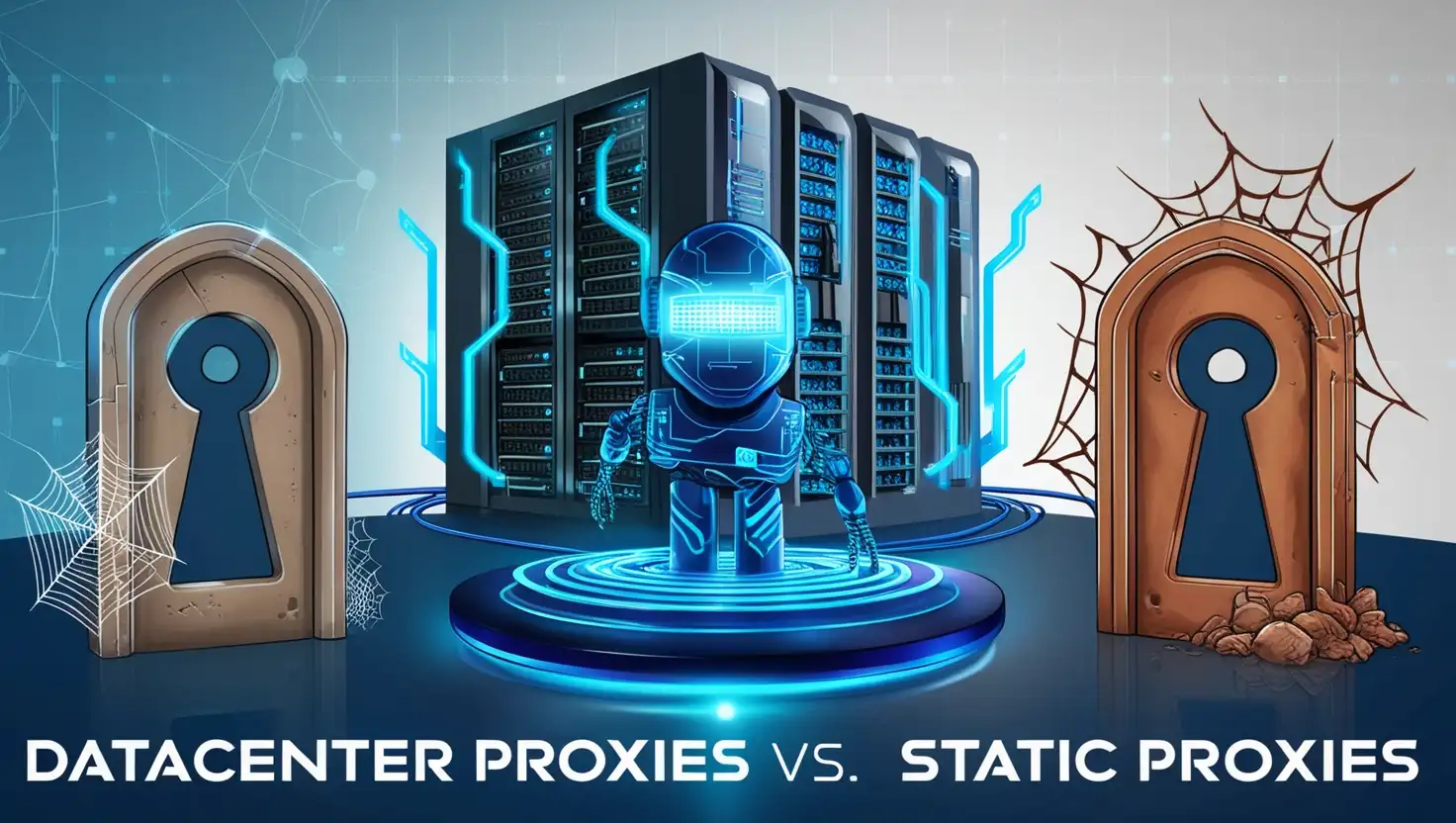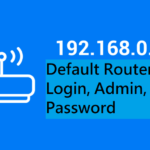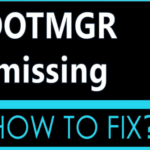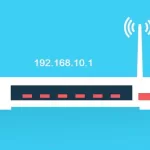Introduction
Their formula is similar to the datacenter proxy between users and online platforms. They enable you to hide your real IP address, increasing privacy and minimizing exposure. But these two proxy types have some major differences that can impact performance, security, and cost.
The proxy you select determines how fast you can collect data, how likely you’ll be to have your IP addresses banned, and how much money it will take to reconnect when you reach an extremely high number of requests. Static proxies may use the same IP over time, while rotating proxies switch the IP after each session or request.

This is important as it affects how you scrape data, how you run social media accounts, how you do research, etc. After reading this post, you will have an idea of advantages and disadvantages of both types and be able to make a choice that fits both your needs and your goals.
What Are Datacenter Proxies?
Datacenter proxies work on servers located in data centers. They usually work with large groups of web servers driven by the proxy service providers. These proxies are high performing since high resource capacity data centers even house them.
Datacenter proxies mask your real IP address and assign one from the server instead by routing your connection through its IP address. This configuration can help to get around basic access restrictions or avoid content blocks on some sites.
Datacenter proxies are different than residential proxies. Residential proxies tap into connections from actual home internet service providers, making them seem as though they originate from everyday household IP addresses.
Compared to datacenter proxies that sometimes receive greater attention because of their centralized networks. Nonetheless, they are still widely used, owing to their lower cost and quick speeds. They work well for many use cases like quick web scrapes, tests, and accessing content.
Core Differences Between Rotating and Static Proxies
Rotating proxies regularly update your IP address. This refresh can occur on every request, after a configurable interval, or on session renewal. This mechanism results in an ever-changing connection pattern that evolves over time and assists in avoiding blanket blocks, along with throttling comments. It also improves privacy, since it is more difficult for the platforms to trace one IP.
Static proxies are others that use the same IP address for a longer time. But they provide stability for tasks requiring persistent sessions like gaming or account management. Static IP, on the other hand, is more prone to detection if a platform tags one IP. Cost is another factor.
Due to the way infrastructure with rotating proxy facilities need to replace their existing IPs and swap them as you connect, these can occasionally be much more expensive. Static proxies can be more affordable or may be priced one per IP. The best choice for you will depend on your needs in terms of level of anonymity, budget, and whether you can cope with a changing connection.
Rotating Proxies:
- Frequent IP changes reduce the risk of blocks.
- Ideal for tasks requiring anonymity and large request volumes.
- Can involve higher costs due to complex infrastructure.
Static Proxies:
- Maintains the same IP over time for consistency.
- Better suited for account management and gaming sessions.
- More vulnerable to detection if the IP is flagged.
Advantages of Rotating Proxies
Rotating proxies rotate their IP addresses, which makes it harder for websites to block or blacklist your connection. This feature is especially useful for web scraping. As you retrieve data from various pages, you spread your requests across multiple IPs. This method reduces the risk of triggers that could stop your scraping project.
Rotating proxies also provide stronger anonymity. Since your connection changes frequently, online services have difficulty building a digital fingerprint tied to one IP. This approach helps with tasks like SEO monitoring, where you might scrape search engine pages without raising alarms.
Additionally, rotating proxies benefit data aggregation projects that involve frequent and repeated requests. The steady IP rotation helps you gather information from different sources without consistent blocks. Overall, rotating proxies shine in scenarios that require high anonymity, large-scale request volume, and protection from IP flags.
Key Benefits of Rotating Proxies:
- Reduced likelihood of IP blacklisting.
- Greater anonymity for web scraping and SEO tracking.
- Efficient handling of repetitive data collection tasks.
Advantages of Static Proxies
Static proxies use a single IP for an extended time, which benefits tasks that rely on a stable connection. This consistency is helpful for account management and gaming. With a static proxy, you can log in from the same IP address every time, reducing triggers linked to suspicious or repeated IP changes. This stable environment also supports session-heavy activities like maintaining an online profile or accessing platforms that monitor IP patterns.
Additionally, static proxies can offer predictable performance levels because they do not switch IPs. This characteristic can simplify troubleshooting if a connection faces issues. Some people prefer static proxies because they are often more economical and require less configuration. By selecting a single IP, you gain a simpler setup that can save time. If you need reliable connectivity and consistent activity, a static proxy might meet your requirements.
Key Benefits of Static Proxies:
- Stable Connection: Uses a single IP for an extended period, ideal for tasks that require consistent access.
- Account Management: Maintains uniform login details, reducing flags linked to rapid IP changes.
- Gaming Compatibility: Supports multiplayer sessions without abrupt IP shifts that could cause disconnections.
- Predictable Performance: Simplifies troubleshooting because you only manage one IP address at a time.
- Cost-Effective: Often available at lower prices, especially when charged per IP rather than per rotation cycle.
- Reduced Configuration: Involves minimal setup since there is no need for continuous IP switching.
Use Cases: Rotating vs. Static Proxies
Rotating proxies will work for any workflow that entails requesting data frequently or accessing any platform repeatedly. Examples include web scraping, competitor analysis, data collection, and SEO tracking. Rotating IPs prevents overuse from a single address, which lowers the chances of being blacklisted. These tasks tend to work with large request volumes, hence, the need for new IP pool real estate.
Static proxies are suited for situations requiring permanent identity signals. Account managers may also need a single IP so that their actions don’t look like they’re coming from random locations. As no one likes to be booted out of an online gaming session when the IP changes, getting a static IP is a plus. There are some security measures that only work effectively when IP changes are held in check. In brief, rotating proxies are for volume-heavy data needs, static proxies are for continuous, session-based operations that benefit from having one IP address.
Performance Comparison
Speed and reliability are key to performance. Datacenter proxies have relatively fast connections, but overall uptime and stability are determined by the choice of rotating and static proxies. Rotating proxies are great for scraping or data one has to pass because they can handle large amounts of requests simultaneously. They spread requests between multiple IPs so that one IP does not get strained.
Static proxies usually have consistent speeds but run into blocks when a platform is able to identify the IP. As long as the IP remains other-than-influenced, the performance is stable over many iterations.
This is advantageous for use cases with a high volume of tasks, as it evenly spreads the load across hundreds of IPs! But for certain tasks that do not activate platform defenses, static proxies can be just as speedy. Before deciding on a proxy type, you need to think about your data needs, how often you need to connect the proxies, and platforms you are targeting.
Security and Privacy Considerations
Security and privacy depend on how difficult it is to track or mark your IP activity. Static proxies operate on one IP, meaning that if that address looks suspicious, your entire operation may be compromised. Rotating proxies reduce that risk as they change IPs frequently. Every new IP resets the battle, lowering the odds of a permanent block.
A rotating proxy also has a privacy advantage: it becomes difficult for observers to tie multiple requests to a single source. This can safeguard sensitive projects that depend on anonymity. But in general, datacenter proxies can be more exposed to anti-fraud tools since they come from server farms instead of personal connections.
They can still see some patterns on platforms that can be blacklisted by IP range. Appropriately weight both types of proxies factors based on your privacy goals and the likelihood of detection in your specific use case.
Residential Proxies vs Datacenter Proxies
Private proxies originate from IP addresses granted by residential ISP. They mimic regular user behavior and are more difficult to spot. Unlike residential proxies, datacenter proxies are owned by servers that are located in data centers. They also tend to be faster and can manage heavier traffic, though they may be flagged more easily by platforms.
The decision between the two depends on your authenticity requirement. A better option if you want to seem like a real home user are residential proxies. You have a lower block rates on some tasks. Nevertheless, Residential proxies are generally more expensive and slower than datacenter proxies.
On the other hand, datacenter proxies are cheaper and are very speedy. They are an excellent choice for simple problems that do not demand peak authenticity. Before deciding between residential and datacenter proxies, consider your projects needs, budget allowance and detection risk.
Proxy Selection that Suits You
You discern the right proxy option based on a few parameters. Consider your budget, since rotating services can involve steeper fees, particularly if you need a lot of IPs. When developing your project, determine your speed requirements. Datacenter proxies usually provide better raw bandwidth than others, but rotating set-ups may end up slowing down a little due to IP switching.
Your choice is also influenced by privacy needs. Rotating proxies can help lower the risk of detection if you want that extra layer of anonymity. For jobs that need sessions to stay persistent, like social media management, well-behaved would look like a static arrangement.
Assess provider reliability by reviewing uptime guarantees, IP quality, and customer reviews. They should be consistent in terms of their performance and support. Striking the right balance is a matter of focusing on your main objectives, evaluating alternatives, and choosing a service you want to grow with in the long run.
Proxy Rotation Explained
Using a set of proxy servers sets up a schedule that rotates through different IP addresses. That could be a new IP every time you send a request or a different IP from a pool after a time interval. You can automate this process with tools, which will make sure your connection changes IPs with no action required from you.
By rotating your requests, you can distribute them across a set of several IPs, reducing your chances of getting blocked or banned. It also prevents your traffic from looking so same-y. Continuing with our “organic” theme: when a site sees requests coming from multiple IPs, that activity might seem more organic.
Stickies sessions that send the same IP for a short time are examples of rotation strategy. If it does, this should be all you need — an important consideration if you want partial consistency. Such rotation minimizes the risk of detection and ensures uninterrupted connectivity, which is essential for scraping, data extraction, or large-scale testing.
How to Choose the Best Proxy Provider for Your Needs.
Ethical Proxy Usage
Using a proxy should be done responsibly, as per the online rules and the privacy of other users. If you take data from website scraping states, do respect their rules and don’t overload the servers with request after request after request. Most sites specify what is and isn’t allowed in their terms of service. Violating these regulations could result in IP bans, lawsuits, or blocked access to data.
Adhering to a respectful manner includes not leveraging upper hand to commit a fraud, decrypt or access unauthorized data. Conducting research responsibly, whether for analytics or business. A few use rate-limiters or introduce back-off times to reduce the pressure on servers.
Doing so preserves a positive environment for everyone. Proper usage safeguards the internet community and ensures trust in data collectors as well as data providers. If you’re gathering a lot of information to analyze, think about rate limiting and public terms to ensure you’re doing things fairly and legally.
Common Proxy Problems and How to Fix Them
An old proxy configuration or load on the provider can cause slow speeds. If you experience lag, try different servers or lower the number of concurrent connections. Change location or you can switch the IP set to check if it’s fix.
IP bans happen when your request number crosses a website’s acceptable limit. To make this work you can reduce your requests rate or expand your IP pool for rotation. It means that they block multiple IPs fast due to their strict stance on scraping activity. To avoid giving yourself away too easily you should check your user agent string, headers and request patterns.
Proxy server if not stable then connection drops sometime. In those instances, check with your proxy provider for status updates, or hop to backup servers. Monitoring error rates and response times regularly gives you an early warning of problems. By adjusting request intervals, utilizing reliable proxies, and monitoring changes to the site’s terms of use, you can ensure that your proxy operations remain seamless.
Advanced Proxy Techniques
Proxy usage capabilities can be extended with advanced methods. Some examples include Proxy chaining Proxy chaining: A proxy chain routes traffic through multiple proxies and is used to send data to a final destination. This method provides greater anonymity because each hop obfuscates the previous server’s identity. It creates added latency, but it can help conceal your real location.
Geo-targeting is an alternative to consider. It enables you to choose IPs from various places to experiment or access local media. For instance, businesses may leverage geo-targeting to verify how ads or offers look in different locations.
This might involve bringing in additional IP pools or adding load balancing, for instance. Big teams tend to use the proxy management tools for traffic distribution, rotation schedules, and performance metrics logging. The discussion of these techniques will help make your solutions more complete with less retries across multiple networks or regions, and in a less restricted set of IPs.
Conclusion
Using high-speed rotating datacenter proxies not only switches between IP addresses for anonymity but also minimizes the chances of being blocked due to excessive requests from one IP.
Static proxies use stable IP addresses, which are great for stable sessions and account access. The use cases of both options cover a wide range of data-oriented tasks. Which to choose comes down to your budget, privacy needs and connection requirements.
Join 25,000+ smart readers—don’t miss out!









